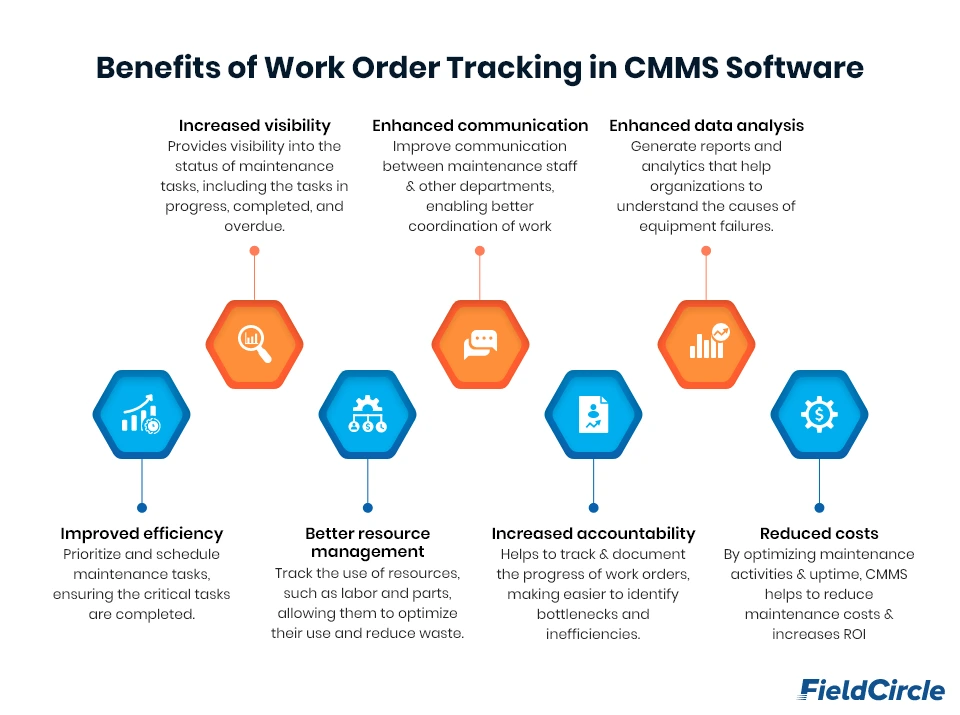Everything You Need to Know About Maintenance Work Order Management in CMMS

Maintenance work orders management can help organizations manage and optimize their maintenance activities by providing visibility into the progress and status of ongoing maintenance work. The common approach to tracking maintenance work orders is by using CMMS. This software can be used to create, assign, and track work orders. The CMMS can also be used to schedule maintenance activities, track the use of resources, and generate reports on the status of work orders.
What is work order tracking in CMMS?
A work order tracking in a CMMS typically includes information such as the description of the maintenance work to be performed, the priority level of the maintenance work, the location of the equipment or facility where the work will be performed, the expected start and completion dates, and the resources (e.g., technicians, parts, tools) required to complete the work.
In a CMMS, work orders can be created and assigned to maintenance staff, and their progress can be tracked and updated as the work is completed.
How do organizations use CMMS for maintenance work order management?
Organizations can use manage maintenance work order in maintenance software and optimize their maintenance activities in several ways. Some common examples include:
Planning and scheduling maintenance: Work order tracking can be used to plan and schedule maintenance activities based on factors such as the priority of the work, the availability of resources, and the maintenance schedules of the equipment or facilities involved.
Tracking progress and performance: It can be used to monitor the progress of ongoing maintenance activities and measure the performance of maintenance staff.
Identifying trends and inefficiencies: By analyzing the data captured in the work order, organizations can identify trends and inefficiencies in their maintenance processes and make improvements to increase efficiency and reduce costs.
Enhancing customer satisfaction: By completing work orders in a timely and efficient manner, organizations can improve their responsiveness to customer needs and reduce the impact of equipment failures on their business operations.
Optimizing resource utilization: It helps organizations optimize the use of their maintenance resources, including technicians, parts, and tools, to ensure that they are being used effectively and efficiently.
What are the benefits of maintenance work order management in CMMS?
Here are some benefits of work order management in CMMS:
Improved efficiency: Work order in maintenance management allows organizations to prioritize and schedule maintenance tasks based on their importance, ensuring that the most critical tasks are completed first. This helps to improve overall efficiency and reduce downtime.
Increased visibility: Tracking work orders provides visibility into the status of maintenance tasks, including which tasks are in progress, which are completed, and which are overdue. This helps managers to identify any potential issues and take corrective action.
Better resource management: It enables organizations to track the use of resources, such as labor and parts, allowing them to optimize their use and reduce waste.
Enhanced communication: CMMS can help improve communication between maintenance staff and other departments within an organization, enabling better coordination of work activities and reducing the risk of delays or misunderstandings.
Increased accountability: CMMS can help organizations track and document the progress of work orders, making it easier to identify bottlenecks and inefficiencies and hold staff accountable for meeting performance targets.
Enhanced data analysis: CMMS can generate reports and analytics that can help organizations understand the causes of equipment failures and identify opportunities for improvement.
Reduced costs: By optimizing maintenance activities and improving equipment uptime, CMMS can help organizations reduce their maintenance costs and increase the return on their investment in maintenance activities.
How does CMMS’ automated work order tracking help organizations to control costs?
Link in compliance safety requirements: By tracking all the work orders completed in compliance with safety requirements, organizations can avoid costly accidents and injuries, as well as fines and penalties for non-compliance.
Extend equipment longevity: By regularly tracking maintenance tasks and addressing issues as they arise, organizations can extend the lifespan of their equipment, reducing the need for costly replacements.
Speed up issue resolution: By prioritizing and tracking work orders, organizations can ensure that issues are resolved promptly, reducing the cost of downtime and lost productivity.
Accurately forecast replacement parts: By tracking the use of parts and supplies, organizations can more accurately forecast when replacements will be needed, reducing the cost of overstocking or running out of supplies.
Overall, tracking work order in maintenance management software can help organizations to control costs by optimizing resource usage, improving efficiency, and minimizing the risk of accidents and equipment failure.
Here is the maintenance work order example that is used in a real-world situation: Imagine that a manufacturing facility has several pieces of production equipment that need to be regularly maintained. Whenever maintenance is needed, a work order is created in the CMMS system. The work order includes details about the equipment that needs maintenance, the type of maintenance that is required, and the schedule for completing the work.
The maintenance team can use the CMMS system to access the work order and see what tasks need to be completed. They can also use the system to track their progress as they complete each task. Once the maintenance is completed, the team can mark the work order as complete in the CMMS system. This updates the status of the work order and ensures that it is accurately reflected in the system.
Summary
Work order tracking in CMMS can be customized to meet the specific needs of an organization and can be accessed from any device with an internet connection. Overall, implementing a CMMS system can help organizations to better manage their maintenance processes and improve overall operational efficiency. Choosing the right CMMS software is a crucial piece of the puzzle. FieldCircle ensures that no work orders are missed by automating the maintenance activities with all capabilities of maintenance management.



